11 Tips Fishing From a Kayak: Ultimate Guide for Beginners
xuanthai
09:09 | 02/07/2025
Fishing from a kayak is an exciting and highly rewarding experience for anglers who want to access hard-to-reach fishing spots while enjoying a more intimate connection with the water. Compared to traditional boat fishing, fishing from a kayak offers simplicity, stealth, and maneuverability that are perfect for lakes, rivers, and coastal waters. For beginners, the idea may seem daunting, but with the right knowledge, equipment, and techniques, it becomes an accessible and enjoyable pursuit. This article will walk you through everything you need to know about fishing from a kayak, helping you make confident decisions and enjoy a more productive time on the water.
Whether you're switching from shore fishing or just exploring new options, the appeal of fishing from a kayak lies in its versatility. You’ll learn how to choose the right kayak, equip it safely, and use it to your advantage in various fishing styles. Each tip in this guide from the Nook Art is designed to help you develop key skills and tactics so that you can maximize your catch while minimizing frustration. Let’s dive into the essential strategies and gear tips that every beginner should know before heading out for their first fishing-from-a-kayak adventure.
Why Fishing from a Kayak is Great?
Fishing from a kayak offers a unique blend of freedom, stealth, and accessibility that makes it ideal for both new and experienced anglers. Unlike traditional boats, kayaks allow you to slip quietly into shallow, fish-rich waters without spooking your target, perfect for sight casting or fly fishing. Their lightweight build enables easy maneuvering through tight spaces like coves, weed beds, and backwater channels.
Here’s why fishing from a kayak is worth considering:
-
Stealth and Silence: No engine noise means you can get closer to fish undetected.
-
Access to Remote Spots: Explore narrow or shallow areas inaccessible to larger boats.
-
Affordability: No fuel, no trailer, and low maintenance costs.
-
Eco-Friendly: Human-powered transport has zero emissions.
-
Quick Launch & Portability: Easy to carry, car-top, or hand-launch in minutes.
Whether you're chasing bass in a lake or redfish along the coast, fishing from a kayak delivers a more intimate and immersive angling experience. It's also an opportunity to simplify your gear, stay active, and connect more deeply with the water and the fish.
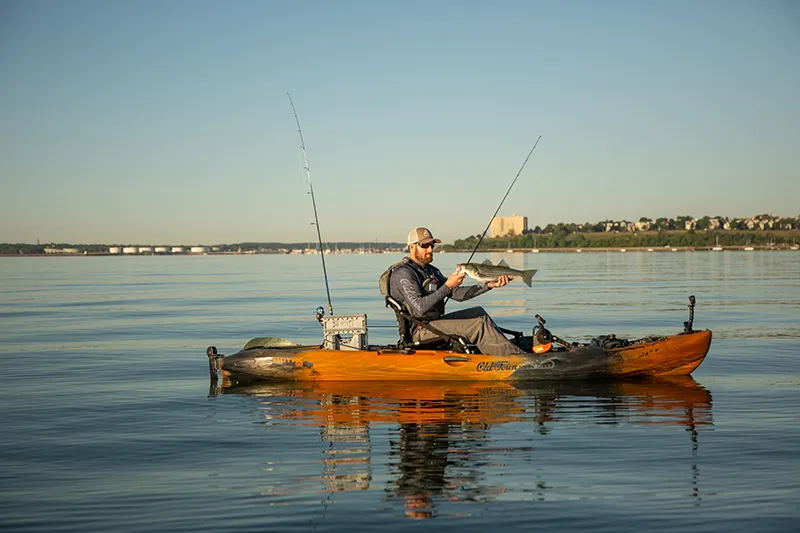
Can You Fish from a Regular Kayak?
Yes, you can fish from a regular kayak, though there are some considerations to keep in mind. While fishing from a kayak specifically built for angling provides better stability and storage, many standard recreational kayaks can still be used effectively, especially for beginners. The key is to focus on the kayak's stability and comfort, as fishing often requires twisting and turning your body while seated for extended periods. With some simple modifications, such as adding rod holders or using a portable anchor, a regular kayak can become a functional fishing platform.
That said, fishing from a kayak not designed for angling does come with limitations. You may lack the space for tackle boxes, coolers, or fish finders, which can reduce efficiency and comfort on longer trips. It's important to test your kayak in calm conditions first and gradually work your way into more complex fishing scenarios. Many anglers start with a basic kayak to explore the sport, then upgrade once they understand the specific features that enhance fishing performance. Regardless of the model, fishing from a kayak offers a unique and rewarding way to access fish-filled waters.
Choosing the Right Fishing Kayak
The first step in fishing from a kayak is selecting the right vessel to match your environment and fishing style. There are several factors to consider, including length, width, hull design, and weight capacity. A wider kayak typically provides more stability, which is especially important for stand-up casting or if you're new to kayak fishing. Meanwhile, longer kayaks track better and are faster, making them ideal for covering large areas or open water.
When fishing from a kayak, your comfort and gear access are critical. Look for kayaks with adjustable seats, ample storage compartments, and mounting options for accessories like rod holders and fish finders. Consider whether you'll be fishing in rivers, lakes, or coastal areas, as each setting demands different handling and stability characteristics. Many modern fishing kayaks offer pedal drive systems for hands-free operation, allowing you to focus entirely on casting and reeling. The right fishing kayak can greatly improve your efficiency and enjoyment on the water.
Sit-on-Top vs Sit-Inside
When it comes to fishing from a kayak, one of the biggest decisions is choosing between a sit-on-top or a sit-inside model. Sit-on-top kayaks are the most popular among anglers because they provide better stability, easier access to gear, and the ability to stand while fishing. They also drain water through scupper holes, making them self-bailing and safer in rough or wet conditions. This design is ideal for warm climates and those who value mobility and flexibility.
On the other hand, sit-inside kayaks offer a more enclosed cockpit, which provides better protection from cold water and wind. They're generally lighter and offer a lower center of gravity, which can improve paddling efficiency in calm conditions. However, they tend to limit your range of motion and gear access, important factors when fishing from a kayak. For most beginners and recreational anglers, sit-on-top models offer a more user-friendly and fishable platform. The best choice ultimately depends on your local environment and personal preference.
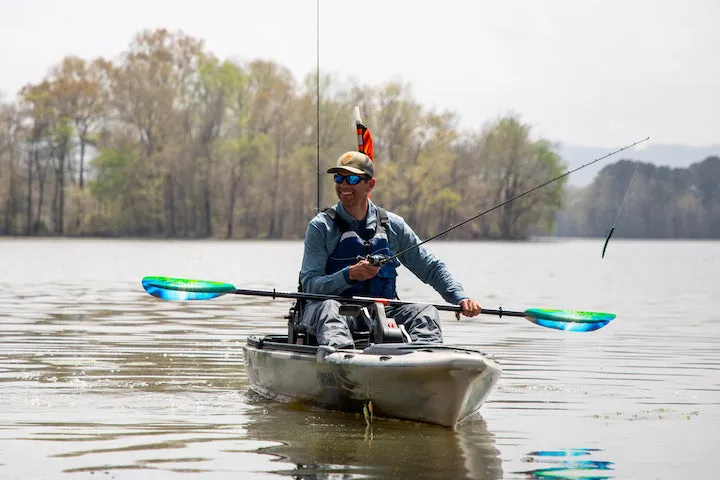
Paddle & Cast Stealthily
When fishing from a kayak, stealth becomes one of your most valuable assets. Without an engine, you're able to glide quietly through the water, significantly reducing the chances of alerting fish to your presence. However, effective stealth goes beyond the absence of noise; it requires careful planning of your boat positioning, deliberate and minimal movements, and the awareness to remain still at the right moments. These nuances can make a major difference in shallow or clear waters, where fish are especially sensitive to disturbances.
Using a paddle leash is helpful because it prevents sudden, noisy interruptions if the paddle slips or is dropped. A feathered stroke technique, where the paddle is gently sliced through the water, minimizes splash and helps maintain quiet movement. It's also wise to pause briefly after reaching your casting location, giving the water a chance to calm before presenting your lure. Finally, always try to position the bow of your kayak toward your casting target to reduce unnecessary movement and improve line control. By mastering these details, you'll develop a smooth and quiet approach that not only improves your chances of hooking fish but also enriches the overall experience of fishing from a kayak.
Drift Fishing / Bait Dragging
Drift fishing is a reliable and efficient method that leverages the natural movement of wind or current to guide your kayak over areas where fish are likely to be. When fishing from a kayak, this technique enables your bait or lure to flow naturally with the environment, which reduces the chance of alarming nearby fish. It also allows you to conserve energy since you’re not constantly paddling or repositioning, making it easier to concentrate on detecting bites and working your rod. Whether you're exploring a broad lake or navigating a tidal inlet, drift fishing offers a controlled and passive way to maximize your water coverage.
To do it effectively, use a drift sock to manage your speed, especially in windy conditions, it slows your movement and improves lure presentation. Monitoring your drift rate using GPS or shoreline landmarks helps ensure you remain in productive zones. Maintaining your rod tip angled forward increases sensitivity and helps detect subtle bites before they’re missed. Slightly heavier lures or jig heads are also helpful, keeping your bait closer to the bottom where many species feed. Fishing from a kayak while drifting blends strategy with simplicity, and as your instincts develop, you’ll learn to read currents and optimize your drift path with precision.
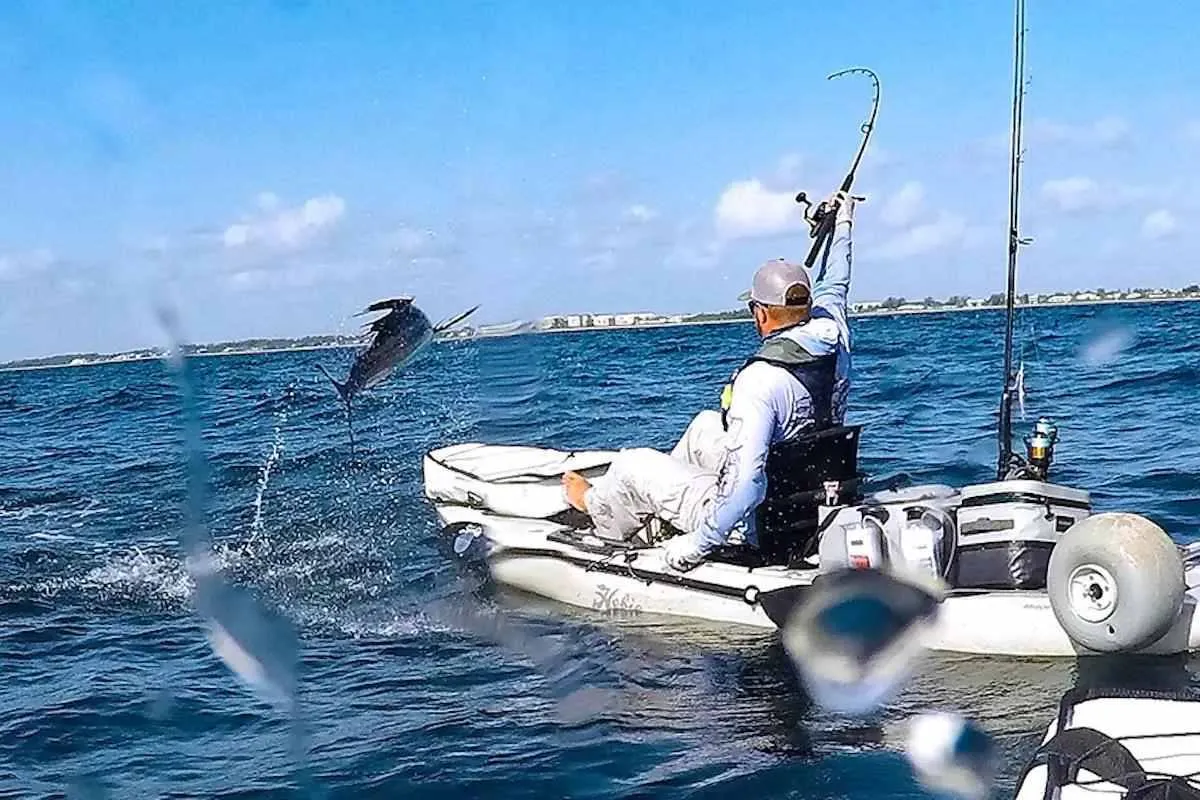
Anchor Trolley
Using an anchor trolley is one of the smartest upgrades you can make when fishing from a kayak, especially in windy or fast-moving waters. It allows you to adjust the anchor's position along the length of your kayak, giving you full control over your orientation in relation to wind and current. This means you can always face your preferred fishing direction without having to constantly paddle or reposition. With a properly installed trolley, anchoring becomes safer and more efficient, helping you stay locked on a productive fishing spot for as long as needed.
An anchor trolley system works by running a pulley line from bow to stern along one side of the kayak, allowing you to move your anchor point by simply sliding a ring. This flexibility helps reduce the risk of tipping that can occur if the kayak is anchored from a fixed mid-point. When targeting fish that are sensitive to sound or movement, fishing from a kayak with a well-placed anchor minimizes drift and keeps your presentation consistent. For anglers who regularly fish in current or wind, an anchor trolley can be the difference between frustration and success.
Casting from a Stable Position
Maintaining stability while casting is one of the key challenges when fishing from a kayak. Because kayaks are narrow and lightweight, even slight body movements can affect your balance, especially during long or overhead casts. To cast effectively and safely, it's essential to understand your kayak's stability limits and practice casting techniques that minimize body rotation. A stable platform allows you to place your lure with precision and gives you confidence to work your rod without fear of tipping.
Start by keeping your center of gravity low, especially if you're seated. If you’re in a kayak that allows standing, test your balance in shallow water first before attempting to cast from a standing position. Always face the direction you plan to cast toward, using your legs and core to stabilize the motion. Grip the rod with smooth, controlled movements rather than quick jerks that could throw off your balance. By refining these techniques, casting while fishing from a kayak becomes second nature and far more productive.
Use of Trolling (Kayak Trolling)
Trolling from a kayak is a highly effective technique for covering water and targeting active, roaming fish species such as trout, mackerel, or striped bass. Unlike motorboats, kayaks allow for slower, quieter trolling speeds, which can actually increase your catch rate when fish are wary or pressure-sensitive. Fishing from a kayak while trolling enables you to present your lure consistently at the right depth while moving through productive zones without startling the fish. It's a low-effort, high-return method that's especially useful during exploratory trips.
To troll effectively, position your rod in a secure holder angled slightly behind you and monitor your lure’s action regularly. Use diving crankbaits, inline weights, or planers to maintain the desired depth. Adjust your paddling rhythm based on water conditions, slow and steady often works best. If you’re using a fish finder, watch for depth changes, bait balls, or structure to guide your path. Kayak trolling lets you multitask efficiently, and with the right setup, it becomes one of the most passive yet productive ways of fishing from a kayak.
Spin Fishing
Spin fishing is one of the most beginner-friendly and versatile methods you can use when fishing from a kayak. It’s ideal for targeting a wide variety of species in both freshwater and saltwater environments. The setup is simple: a spinning reel paired with a medium-action rod and a basic lure or bait is often all you need to get started. From your kayak, spin fishing allows for both casting and trolling techniques, making it adaptable to many conditions.
When fishing from a kayak, casting with a spinning rod offers excellent control and accuracy, even when seated. Lightweight gear also reduces fatigue during long sessions on the water. Because kayaks enable a stealthy approach, you can get closer to your target zone, increasing your chances of a successful cast. Spin fishing also allows quick lure changes, giving you flexibility as conditions change throughout the day. For its simplicity, effectiveness, and adaptability, spin fishing is a highly recommended starting point for those new to kayak angling.
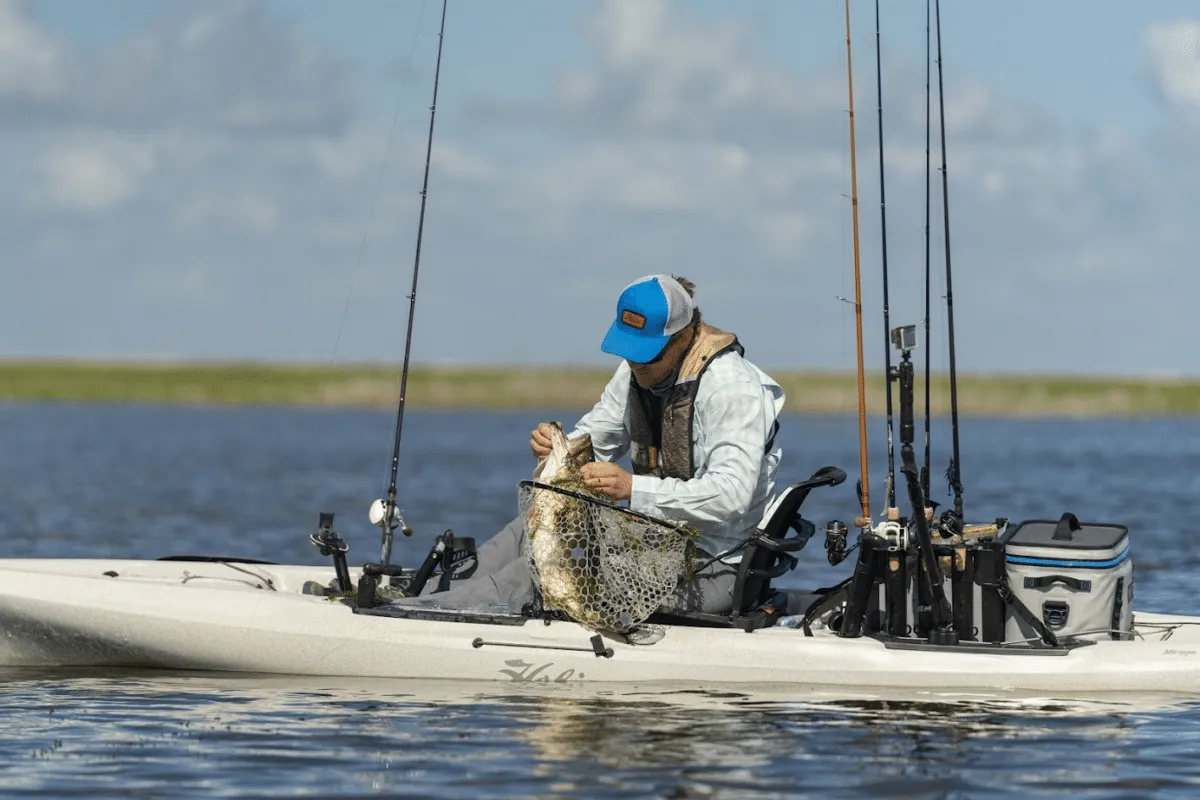
Bottom Fishing & Jigging
Bottom fishing and jigging are excellent techniques for targeting species that stay near the lake or seabed, such as grouper, snapper, or catfish. When fishing from a kayak, these methods become even more productive because of the quiet nature of your approach, which allows you to hover undetected over potential hotspots. Bottom fishing involves dropping baited rigs straight down and waiting for a bite, while jigging requires more active rod movement to mimic fleeing prey. Both methods are well-suited to vertical presentation from a seated kayak position.
To get the most out of bottom fishing from a kayak, use a fish finder to locate drop-offs, reefs, or submerged structures. Select the appropriate weight to ensure your rig stays close to the bottom without drifting too much in current. With jigging, choose lures that match the target species’ diet and adjust your motion to the water depth and lure response. These techniques are especially valuable when fishing from a kayak in deeper water or around underwater structure where game fish concentrate. Their vertical nature complements the kayak’s size and positioning, making them smart additions to your skill set.
Fly Fishing from Kayak
Fly fishing from a kayak combines the challenge of fly casting with the agility and access of a small watercraft. While it requires a higher skill level, it opens up new opportunities to reach shallow flats, backwaters, and pockets where traditional wading or boating isn't feasible. Fishing from a kayak allows fly anglers to move silently across calm waters, getting closer to wary fish like redfish or carp without spooking them. The low profile and minimal disturbance give fly presentations a more natural and appealing quality.
To be successful, choose a stable kayak that allows you to stand or at least provides enough room for a clean casting stroke. Keep your gear organized and accessible since space is limited. Use shorter fly rods when needed to reduce casting difficulty in seated positions. Pay attention to wind direction and boat orientation to avoid tangling your line. While more technical than other methods, fly fishing from a kayak is deeply rewarding for those seeking a quiet, intimate fishing experience.
Kayak Propeller Control
Kayak propulsion systems, such as pedal drives or electric motors, offer hands-free mobility that enhances fishing efficiency. When fishing from a kayak, having reliable, responsive movement lets you make quick adjustments without dropping your rod or paddle. Pedal-powered kayaks free up your hands for casting and reeling, making them especially useful in windy or high-current situations. Meanwhile, electric motors offer longer range and precision control for navigating complex shorelines or structure-heavy areas.
Learning to operate your kayak’s propulsion system smoothly is essential to maintaining boat positioning while casting or fighting a fish. Make minor course adjustments rather than abrupt turns to avoid disturbing fish. Always consider noise levels, especially when using motors, to preserve the stealth advantage of fishing from a kayak. Choosing the right system depends on your fishing goals, location, and budget, but having this level of control transforms how effectively you can cover water and adapt to conditions.
Strategic Drift & Line-Boat Interaction
Understanding how your kayak drifts, and how your line interacts with that drift, is crucial for successful presentations. As wind and current move your kayak, they also affect your lure's depth and angle, which in turn impacts how natural your bait appears to fish. Managing this drift-line relationship is key to presenting lures effectively while fishing from a kayak. It allows you to maintain a consistent strike zone and feel subtle bites more clearly.
To optimize this dynamic, adjust your drift speed using a drift sock or anchor trolley. Maintain a line angle that keeps your bait in the target area for as long as possible without excessive slack. Monitor how changes in kayak orientation alter lure behavior. With experience, you’ll develop an instinct for adjusting your boat’s position based on where your line enters the water. Mastering this interaction adds finesse and accuracy to your kayak fishing techniques.
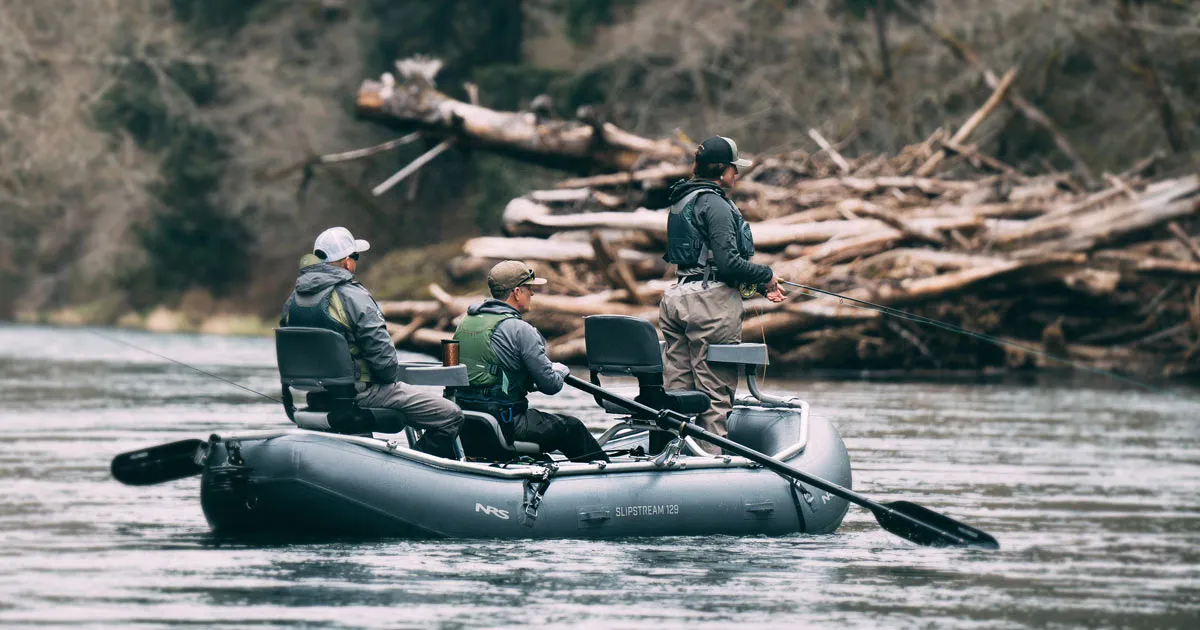
Anchoring / Stake-Out Positioning
Anchoring is one of the best ways to hold your kayak in place over promising fishing areas. Whether you’re fishing in a tidal flat or hovering near structure, staying put lets you focus more on your presentation and less on boat control. Stake-out poles offer a simple, quiet alternative in shallow water, allowing you to silently secure your kayak without anchors or ropes. When fishing from a kayak, anchoring effectively means more time casting and less time adjusting your position.
Choose anchor weights appropriate for the depth and bottom type, lighter grapnel anchors for rock or reef, heavier flukes for sand or mud. Always use an anchor trolley system for flexible positioning and to avoid tipping the kayak. Stake-out poles are best for water less than five feet deep, giving you quick deployment and retrieval with minimal effort. These tools allow precise boat placement, making them essential when fish are holding tight to a particular spot or structure.
Efficient Gear & Safety Management
Being organized and prepared is essential when fishing from a kayak due to limited space and the need for self-reliance. Every item on board should have a purpose and a designated location to prevent clutter and improve efficiency. Start by prioritizing essential gear: rods, tackle, anchor system, safety gear, and navigation tools. Use milk crates, dry bags, or kayak-specific storage systems to keep everything within reach but secure.
Safety should always come first. Wear a PFD (personal flotation device) at all times, and carry a whistle, light, and communication device. Know the weather forecast and water conditions before launching. Bring water, sunscreen, and a basic first-aid kit. When fishing from a kayak, good gear management and safety habits not only protect you, they also let you focus entirely on the fishing itself, with fewer distractions or risks.
More Kayak Fishing Tips
The more time you spend on the water, the more efficient and skilled you’ll become. To continue improving while fishing from a kayak, focus on building your water reading skills, watch for structure, bait activity, and wind direction. Practice paddling in wind and current to improve your control. Learn from experienced kayak anglers through videos, forums, or local meetups.
Other useful tips include:
-
Launch early to beat boat traffic and fish during cooler, active periods.
-
Use polarized sunglasses to spot underwater structure.
-
Keep a multi-tool or knife accessible for emergencies or gear adjustments.
-
Always secure rods and valuables with leashes or floatation devices.
The more you refine your setup and technique, the more confident and productive your kayak fishing trips will become. Every outing offers a new opportunity to improve and connect with nature.
Conclusion
Fishing from a kayak is a rewarding blend of sport, strategy, and serenity. It grants access to hidden waters, encourages quiet observation, and demands attention to movement and detail. Whether you're bottom fishing, trolling, fly casting, or simply drifting with the current, fishing from a kayak challenges you to be more aware and more connected with your environment.
With the right equipment, mindset, and safety practices, you’ll find kayak fishing to be not only effective but also deeply fulfilling. As you develop your skills, you’ll unlock new opportunities to catch fish in places most anglers can’t reach. Embrace the learning curve, enjoy the journey, and let fishing from a kayak transform the way you experience the water.
Original
100% hand-drawn, no stock images. Every design is uniquely crafted for a truly authentic experience.
Easy
Designed for effortless coloring with smooth lines and clear layouts—perfect for beginners and pros alike.
Creative
Transform every page into your own masterpiece. Add details, mix colors, and let your imagination run free.
Unique
No two books are the same. Each one offers a fresh, inspiring journey tailored to your creativity.
Blogs
Blog Posts
Let’s dive into the colorful world of coloring!We’ll share some fun típ to help you create amazing works of art



